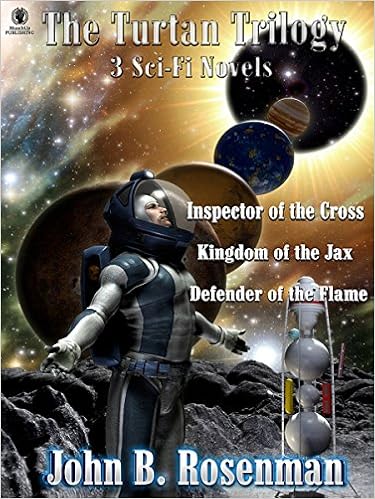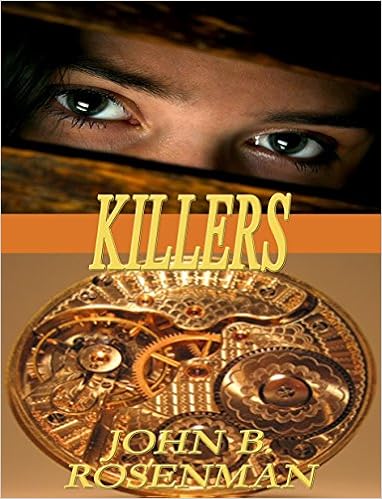Today's guest of honor is John. B. Rosenman, a retired college instructor and an amazingly prolific author of sci-fi, fantasy and horror. It's a pleasure to have him as my guest, because I finally got a chance to ask all those burning questions. Such as ... How in the world do you avoid plagiarism in the world of sci-fi? And what do you do if you accidentally "borrow" from another author's concept?
______________________________
MJN:
You are a retired Norfolk State University professor. One of your
accomplishments was to design and teach a course on how to write science
fiction. You have written and published about 350 stories. To me that's
mind-boggling. How do you keep coming up with original concepts? There are so
many sci-fi authors out there and only a finite number of yet unexplored
concepts.
JBR: Good question,
Marina. Of course, coming up with
original concepts is a problem in all fiction, not just science fiction. You can unintentionally reinvent the wheel in
mainstream fiction, mysteries, westerns, romance fiction, you-name-it. The problem is more pronounced in science
fiction because it’s so conceptually rich and if you recycle a saga about a
distant world with gigantic creatures burrowing through the sand, it’s instantly
recognizable. Readers will shout, “Whoa,
Frank Herbert already did that in Dune. It’s a rip-off!”
So you read as much
science fiction and science fantasy as you can to become as familiar as
possible with what’s been done. That
experience will provide you with some radar. However, it can’t provide complete protection
because science fiction is so vast. It’s the largest genre and in my opinion
embraces all the others. Yes, it has a
finite number of yet unexplored concepts, but you can present even traditional concepts
in an infinite number of ways. You know,
often you can make old wine new by putting it in a new bottle.
If I venture into
familiar territory, I strive to make it original through the way I treat it.
For example, there have been countless stories and novels that have dealt with an
alien invasion from space. Perhaps H. G.
Wells’s The War of the Worlds is the
best known. Well, I’ve explored this
concept in several novels. I try to keep
it fresh by giving it a unique slant in my approach and language. In ASenseless Act of Beauty, ships from two hundred worlds invade Viridis, a
beautiful African planet to colonize it just as Europeans invaded Africa. I also present this event through multiple
viewpoints, including an alien’s. In my
Inspector of the Cross series, I deliberately expanded Joe Haldeman’s
prize-winning The Forever War. Thanks to time dilation, Haldeman’s hero reaches
a thousand years of age. Talk about a
long war! Ah, but my hero is four
thousand years old and counting, and unlike Private Mandella, Inspector Turtan
is humanity’s best soldier and only hope.
I used to visit a
local Barnes & Noble and stroll about, letting my eyes and mind wander. Suddenly, I’d see a book or person and BAM!,
an idea would just leap into my head.
Sometimes it was sheer magic. I
once saw a book called The Calm Technique
and another title, The Death Technique, sprang
into my mind. The character in my story
has the ability to physically decompose, become a corpse, and then reverse the
process. That is his “technique.” Was this
concept original and new enough? I had
to trust in my vision and ability when I wrote it.
MJN:
Have you ever encountered a short story or a novella where you scratched your
head and said, "Huh, this reminds me of something I wrote." Sci-fi
writers often travel in the same circles. So when you have so much of
your material "out there", I'm sure you are wondering, "Okay,
who is reading my stuff and getting ideas from it?"
JBR: This doesn’t happen
to me much. I have read stories where
the Devil appears and threatens mankind. When I do, I’ve occasionally been reminded of
my dark fantasy story “The Last Snowman,” in which a young boy has to protect a
snowman from Satan to save humanity. But
I thought my story was original when I wrote it and I still do. That’s what I mean when I say you can take an
old concept and make it new. If writers
couldn’t do this, fiction would stagnate.
In the last few days,
an individual has responded to an ad for one of my novels by asking if he could
write a script for it. Now there’s a
twist! I know that bits and pieces of
what I read occasionally remind me of stuff I’ve written, but it doesn’t happen
often. I do hope though that my
scribbles have sparked other writers’ imaginations and they are getting ideas
from me—as long as they don’t plagiarize and outright steal.
MJN:
You have over 20 books with various
genre presses, many of which put out predominantly e-books. I always
thought that with new advancements in publishing technology, a digital book
should be a multisensory experience, with special sound effects and
illustrations and animated videos. Like a graphic novel only one notch
up.
JBR: Hey, Marina, that
sounds like science fiction! J Well, actually it isn’t, and you’re absolutely
right. Enhanced eBooks include embedded
media, interactivity, narration, etc., and here’s one link concerning them: http://ebookarchitects.com/learn-about-ebooks/enhanced-ebooks/
I don’t know about
other folks, but my Kindle Paperwhite only accommodates static books with texts
and pictures. No moving parts or animation, no voiceover. That’s okay, though, since I only made the leap
to Kindle four or five months ago.
That’s right, I had published all these eBooks, but if I wanted to read
them and others, I had to do it off my computer screen.
I have little doubt
that such books will become increasingly common. The eBook revolution or
evolution is here to stay, and more and more bells and whistles will be
developed, especially since customers will demand them. Where there’s a demand, they will find a
way. You know, I’ve had five audio books
published, and there’s no reason they can’t evolve, too. Just imagine what they might become when
other media are added.
Here’s an idea:
eventually we will not only be able to interact with these books, but enter
them. We will live in our own virtual
worlds, beyond our physical bodies.
MJN:
Your Turtan Trilogy is a sci-fi romance. How do you combine
the two styles in equal measure? Would you say it's more sci-fi with
romantic elements, or romance set in another universe? I know there's
that category "paranormal" romance. But I imagine, sci-fi
romance is substantially different.
JBR: It’s more sci-fi with
romantic elements. While the romantic
relationship is important, it’s not the main thing. Some of my novels have been categorized
differently. Sci-fi Romantic Adventure
is one example. One of my novels, Dark Wizard is categorized as Paranormal
Romance, but there are sci-fi elements present. They are relatively slight,
though. Sci-fi romance features science
fiction more. For instance, my novel Beyond Those Distant Stars is about a
female cyborg who captains a ship from star to star. She has a romance with a Jump Pilot whose
brain is usually detached from his body so he can directly operate and control
the ship. All this presupposes an
advanced science which can make such achievements possible. Their romance is important and occurs while
they are fighting the alien invaders, but it’s secondary or subordinate to the
Space Opera main plot. It’s possible to
have a story or novel that is a combination of paranormal, sci-fi, fantasy,
horror, comedy, YA and other elements so that classifying it is difficult. Instead of being easily pigeonholed, it may
be a hybrid of several ingredients.
MJN:
You have contributed to several anthologies, as many sci-fi authors do.
Is there a science to making a successful, harmonious anthology, in which every
story fits like a mosaic piece? I'm asking because I've read some fantastic
anthologies, that have a very organic flow to them, tied with a loose
theme. And then there are anthologies that taste like peanut butter and
chicken fingers and sliced strawberries on the same plate.
JBR: Part of it is science; part of it is feel. It’s important to analyze and crunch numbers, but editors should realize it’s an art as well. I just had a story accepted by ROAR7, an anthology devoted to furry creatures or anthropomorphic animal figures. We’re thinking mainly of fierce critters here, aren’t we? Lions, tigers, and bears. Well, my 8 K story, “A Touch of Magic,” is about a sentient Teddy bear. Why not? She’s furry, isn’t she? And sometimes she looks like she’s about to roar. The thing is, you have to decide how broadly or narrowly you’re going to define and interpret the guidelines. Sometimes a radical or unexpected submission will ignite and illuminate the collection and make you look at the subject in a new way.
As editors accept the stories or pieces, they should think about the arrangement. What goes where? Usually the first and last selections are especially important. Do some of the stories have a similar theme or flavor? Perhaps they should be grouped together. Is one story especially dark or gloomy? Perhaps it should be followed by a cheerful or lighter one. Your reference to “organic flow” is crucial. A good anthology seems almost to be a living organism whose parts interact and complement each other. Even a slight rearrangement of them would diminish the total effect.




Thanks for having me as a guest, Marina. The presentation looks great. Visitors, please ask me a few questions about my comments. I'll be glad to answer them.
ReplyDelete